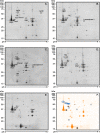Immunoproteomic analysis to identify Shiga toxin-producing Escherichia coli outer membrane proteins expressed during human infection
- PMID: 25156722
- PMCID: PMC4249345
- DOI: 10.1128/IAI.02030-14
Immunoproteomic analysis to identify Shiga toxin-producing Escherichia coli outer membrane proteins expressed during human infection
Abstract
Shiga-toxin producing Escherichia coli (STEC) is the etiologic agent of acute diarrhea, dysentery, and hemolytic-uremic syndrome (HUS). There is no approved vaccine for STEC infection in humans, and antibiotic use is contraindicated, as it promotes Shiga toxin production. In order to identify STEC-associated antigens and immunogenic proteins, outer membrane proteins (OMPs) were extracted from STEC O26:H11, O103, O113:H21, and O157:H7 strains, and commensal E. coli strain HS was used as a control. SDS-PAGE, two-dimensional-PAGE analysis, Western blot assays using sera from pediatric HUS patients and controls, and matrix-assisted laser desorption ionization-tandem time of flight analyses were used to identify 12 immunogenic OMPs, some of which were not reactive with control sera. Importantly, seven of these proteins have not been previously reported to be immunogenic in STEC strains. Among these seven proteins, OmpT and Cah displayed IgG and IgA reactivity with sera from HUS patients. Genes encoding these two proteins were present in a majority of STEC strains. Knowledge of the antigens produced during infection of the host and the immune response to those antigens will be important for future vaccine development.
Copyright © 2014, American Society for Microbiology. All Rights Reserved.
Figures




Similar articles
-
Antibody response to lipopolysaccharides and recombinant proteins of Shiga toxin (STX)-producing Escherichia coli (STEC) in children with haemolytic uraemic syndrome in Poland.Lett Appl Microbiol. 2020 Jun;70(6):440-446. doi: 10.1111/lam.13295. Epub 2020 Apr 28. Lett Appl Microbiol. 2020. PMID: 32270510
-
Detection of Shiga toxin-producing Escherichia coli serotypes O26:H11, O103:H2, O111:H8, O145:H28, and O157:H7 in raw-milk cheeses by using multiplex real-time PCR.Appl Environ Microbiol. 2011 Mar;77(6):2035-41. doi: 10.1128/AEM.02089-10. Epub 2011 Jan 14. Appl Environ Microbiol. 2011. PMID: 21239543 Free PMC article.
-
Molecular Characterization of Shiga Toxin-Producing Escherichia coli Strains Isolated in Poland.Pol J Microbiol. 2016 Aug 26;65(3):261-269. doi: 10.5604/17331331.1215601. Pol J Microbiol. 2016. PMID: 29334059
-
Hemolytic uremic syndrome due to Shiga toxin-producing Escherichia coli infection.Med Mal Infect. 2018 May;48(3):167-174. doi: 10.1016/j.medmal.2017.09.012. Epub 2017 Oct 18. Med Mal Infect. 2018. PMID: 29054297 Review.
-
Shiga toxin-producing Escherichia coli.Adv Appl Microbiol. 2014;86:145-97. doi: 10.1016/B978-0-12-800262-9.00003-2. Adv Appl Microbiol. 2014. PMID: 24377855 Review.
Cited by
-
Role of Lipopolysaccharide in Protecting OmpT from Autoproteolysis during In Vitro Refolding.Biomolecules. 2020 Jun 18;10(6):922. doi: 10.3390/biom10060922. Biomolecules. 2020. PMID: 32570704 Free PMC article.
-
Determination of virulence and fitness genes associated with the pheU, pheV and selC integration sites of LEE-negative food-borne Shiga toxin-producing Escherichia coli strains.Gut Pathog. 2018 Oct 8;10:43. doi: 10.1186/s13099-018-0271-8. eCollection 2018. Gut Pathog. 2018. PMID: 30337962 Free PMC article.
-
Pyruvate: Ferredoxin oxidoreductase is involved in IgA-related microbiota dysbiosis and intestinal inflammation.Front Immunol. 2022 Dec 7;13:1040774. doi: 10.3389/fimmu.2022.1040774. eCollection 2022. Front Immunol. 2022. PMID: 36569858 Free PMC article.
-
EF-Tu From Non-typeable Haemophilus influenzae Is an Immunogenic Surface-Exposed Protein Targeted by Bactericidal Antibodies.Front Immunol. 2018 Dec 18;9:2910. doi: 10.3389/fimmu.2018.02910. eCollection 2018. Front Immunol. 2018. PMID: 30619274 Free PMC article.
-
Cumulative acquisition of pathogenicity islands has shaped virulence potential and contributed to the emergence of LEE-negative Shiga toxin-producing Escherichia coli strains.Emerg Microbes Infect. 2019;8(1):486-502. doi: 10.1080/22221751.2019.1595985. Emerg Microbes Infect. 2019. PMID: 30924410 Free PMC article.
References
-
- Rivas M, Miliwebsky E, Chinen I, Deza N, Leotta GA. 2006. The epidemiology of hemolytic uremic syndrome in Argentina. Diagnosis of the etiologic agent, reservoirs and routes of transmission. Medicina (Buenos Aires) 66:27–32. - PubMed
-
- Scientific Working Group Meeting, WHO. 1998. Zoonotic non-O157 Shiga toxin-producing Escherichia coli (STEC). Scientific Working Group Meeting, WHO, Berlin, Germany.
Publication types
MeSH terms
Substances
LinkOut - more resources
Full Text Sources
Other Literature Sources
Medical
Miscellaneous

